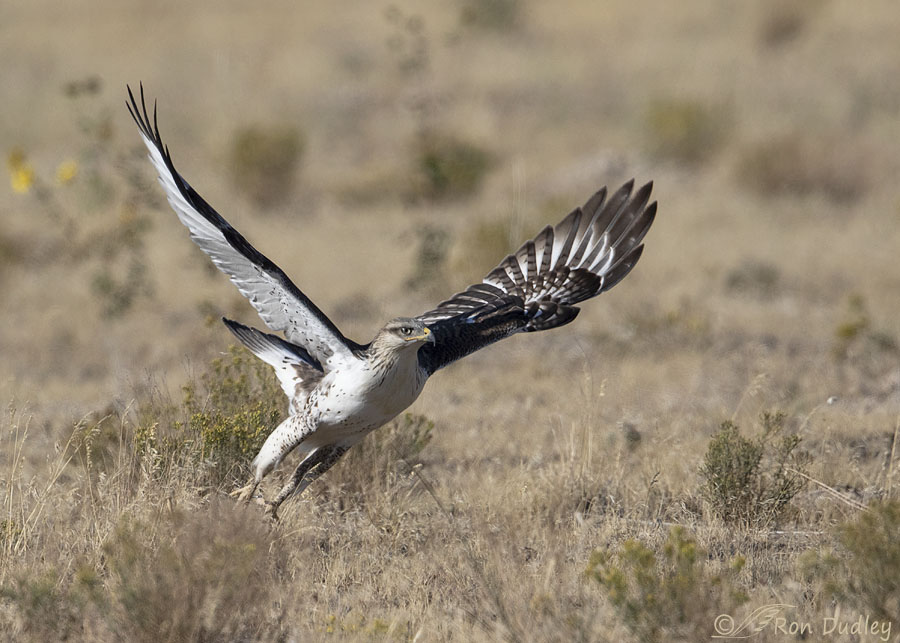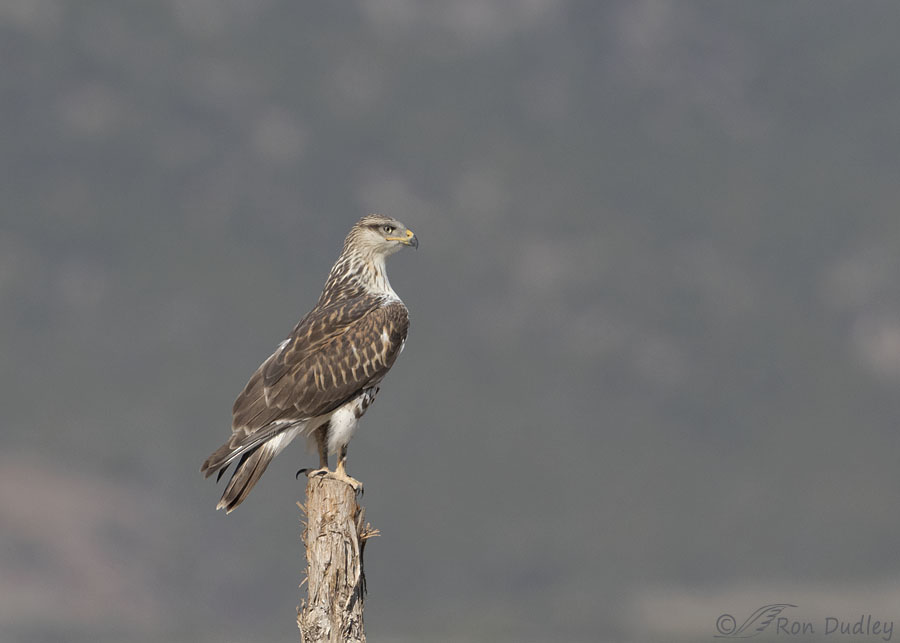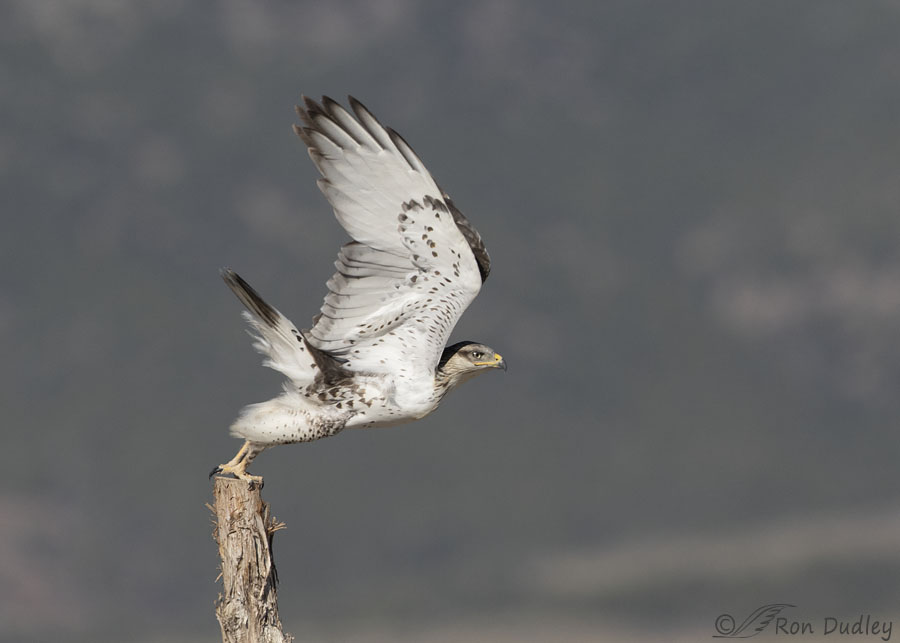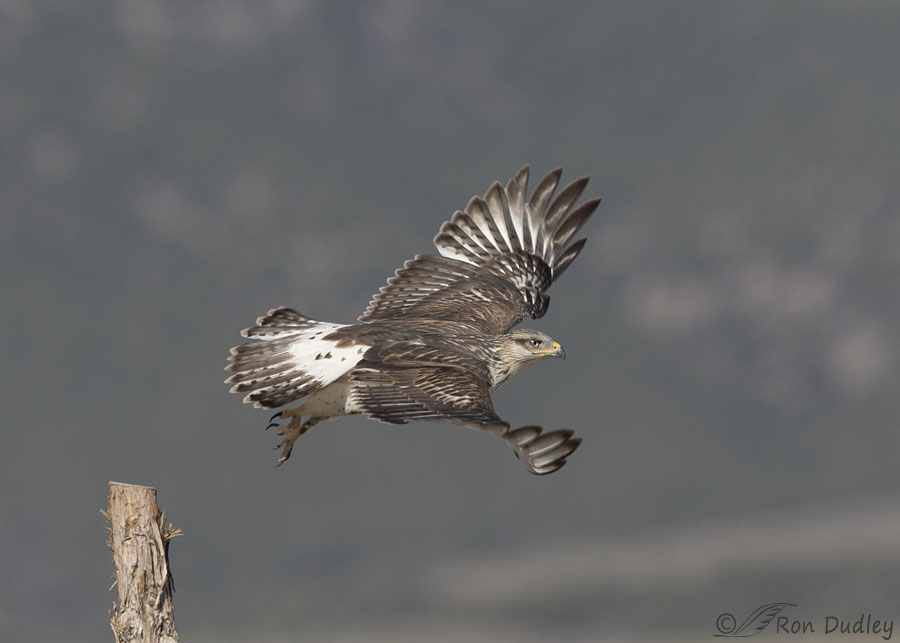At least I think it’s the same bird I photographed four days ago. They were in the same area, they were both young birds and they were using the same hunting technique from the same fence line.

1/4000, f/6.3, ISO 400, Canon 7D Mark II, Canon EF 500mm f/4L IS II USM + EF 1.4 III Extender, not baited, set up or called in
Once again ‘he’ used the line of wooden fence posts to hunt from and repeatedly flew out, either to the north or south, in an attempt to capture prey (probably voles) in the far away grasses. And once again I never saw him capture prey, not even once, but it sure wasn’t for lack of trying. He’s an immature bird so I suspect he’s still ironing out the kinks in his hunting technique. If failure is the best teacher this guy should eventually become a deadly hunter.
In this photo he’s taking off to fly back to one of the fence posts after yet another unsuccessful attempt at prey.

1/3200, f/6.3, ISO 400, Canon 7D Mark II, Canon EF 500mm f/4L IS II USM, not baited, set up or called in
Here he’s scanning the grasses to the north for prey.
In this instance I didn’t choose a very good distance from him to stop my pickup for photos. With my teleconverter attached I was a little too close for takeoff and flight shots and I was a little too far away with it removed for good detail. As a result neither my perched or my takeoff shots of him had the same high image quality is they did four days ago.
It didn’t take him long to spot potential prey to the north so he…

1/3200, f/6.3, ISO 400, Canon 7D Mark II, Canon EF 500mm f/4L IS II USM, not baited, set up or called in
took off after it.

1/3200, f/6.3, ISO 400, Canon 7D Mark II, Canon EF 500mm f/4L IS II USM, not baited, set up or called in
This is the next shot in the burst. Thankfully when he left the post he tilted his body toward me which provided a good look at most of his dorsal surfaces.
One of the reasons I wanted to post this series, despite its lack of the highest image quality, is because it illustrates something I tried to explain in my previous post about him. Readers will recall that four days ago I clipped his wing when he was taking off because he took off at a steeper angle than I expected him to. Ferruginous Hawks are our largest and heaviest hawks so when they take off from elevated perches their takeoff angle usually isn’t very steep. Steep takeoff angles waste energy unless there’s good reason for them.
In this series he’s taking off horizontally which is more typical for heavy-bodied Ferrugs on elevated perches.
It’s a good thing for bird photographers to learn the habits of their subjects but that’s no guarantee they’ll always do what we expect them to. All we can do is play the odds.
Ron


The last photograph made me realize that though I’ve seen many a takeoff shot, how many times have we gotten to observe the underside of a wingtip at that angle? It almost looks as if the Ferruginous Hawk’s fingers – er, feathers are pressed against glass.
The angle of the right wing in the last shot is gorgeous!
He is a beautiful bird, I really like the last 2 shots. These are as good as I can get on a good day!
Many song birds take off vertically or rather drop down from a perch to gain speed then open their wings and glide a short period to get wind under the wings then with a strong wing stokes pushing the air downward head upwards.
As adorable as I find voles and other small rodents, I do hope that this hawk was able to get some breakfast (or at least lunch or dinner). He’s such a strikingly handsome bird now. I hope you come across him when he’s a fully matured adult –he’ll be stunning!
Marty, I’m amazed by what has apparently happened to that area – vole wise at least. There have been virtually no raptors in that area all summer, almost certainly because the drought decimated the vole population.
But then about a month ago we had several good rains, one of them drenching, and the vole populations have apparently rebounded – based on how often I’ve seen this bird go after them.
Vole gestation takes only 3 weeks or less with up to 11 babies in a litter. And they can have as many as 17 litters per year so it doesn’t take them long to rebound in the right conditions!
In our continuing drought things are likely to go south again but it’s nice while it lasts.
Glad that the vole population is so resilient, as they are such an important part of so many food webs.
Birds will always keep you/us guessing. And experience is no guarantee is it?
Another series that fills me with delight. I was taken by the way he seems to be leaning into the takeoff in the third photo, and that glorious feather curl in the next…
Nope, no guarantee. With birds there are no guarantees – not ever.
How wonderful that you got another chance to photograph this gorgeous raptor! He may not be the great hunter just yet, but he’s clearly got the right form and I have high hopes he will perfect his moves soon enough. I really want him to be in that cohort that survives to adulthood! ♥️
“I really want him to be in that cohort that survives to adulthood”
Amen to that, Chris. Life’s tough out there for these birds, especially the young ones.
“The right form” aptly describes that pose while he’s “scanning the grasses for prey”!!
Exactly what I was thinking, Terri! And those eyes mean business!
He was extremely focused on his hunting.
Very majestic and beautiful.
Thanks, Janice.
Judging by your photos he is becoming very adept at takeoffs. Boy, he is one handsome bird.
He must be getting very hungry. Four days without success
Lyle, if you go back and look at the photos from four days ago his crop appeared to be quite full. I think overall he’s getting enough to eat.
Wow Ron> you take us on a magnificent “soaring adventure ” with your gift of photography As others say also: we learn so much from your sharing of photos and knowledgeable comments…and you are seemingly so humble
As others say also: we learn so much from your sharing of photos and knowledgeable comments…and you are seemingly so humble 

 Carolyn
Carolyn
I admire your sense of traveling adventure to go find your locations too
Many thanks to you
“and you are seemingly so humble”
Just being realistic, Carolyn… Thanks very much.
Thanks very much.
Sensational series Ron! Thanks for sharing.
Charlotte Norton
Thanks, Charlotte.
If I were you, I would go back there today!
John, I’m tied up with other things for at least the next three days. Besides I try to avoid going out on weekends, especially with various hunting seasons starting up.
Once again I am blown away by your photos snd what I can learn from them and your comments.
Thanks very much, Deedee.
What a magnificent bird ! Shots #2 and #3 display what I’d thought before to
be an extra-long or extended neck– but now I think that it appears that way because he’s still young, and his neck hasn’t fully bulked up in the way those of
mature birds do– probably as musculature fully develops from more and more
exercise. I surely hope that you’ll have him as a subject many more times.
I sure hope to find him again, Kris. More than once!
Another excellent set of a very beautiful bird. Really like the last one, and in the second one he looks very majestic. That last sentence is so accurate. I have taken hundreds of take off photos of our eagles and think I really know their habits, but so often when I think he or she will dive from this particular perch, of course they lift straight up and go in a different direction. Maybe they know what I am thinking and laugh as they fly off.
Everett, often it depends on any wind that may be present. If they take off into the wind, as they prefer to do when it’s practical for their purposes, they’ll typically take off at a steeper angle to take full advantage of the wind.
Thanks Ron – I made a note to remember that.
Love these shots for their beauty but also enjoy and appreciate them for the illustration of behaviour. And hey, on the internet, who can really tell that much about image quality? I’m just grateful you chose to post them for us to enjoy.
“on the internet, who can really tell that much about image quality?”
That’s a good point, Granny Pat. But when you compare these photos to the earlier ones the difference is apparent, even at this resolution.
Beautiful shots, Ron! #3 in particular appeals to me…. Besides size , the dramatic difference between dorsal and ventral coloring is VERY helpful for ID purposes.
#3 in particular appeals to me…. Besides size , the dramatic difference between dorsal and ventral coloring is VERY helpful for ID purposes.
Thanks, Judy. And you’re right about those field marks.
.
Beautiful shots!!
Thanks, Dick.